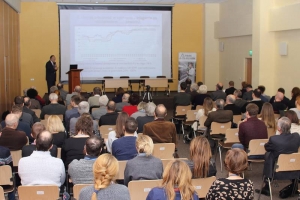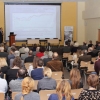Discussion on nuclear power costs and its role in power balance
2017.01.14 0:14 - adminOn January 9, 2017 a seminar on nuclear power costs and its role in power balance in Poland was held in NCBJ. Ideas presented by Professor Strupczewski in his lecture were confronted with some critique. Dr. Weissbach concluded the seminar with a lecture on the ratio of energy supplied/energy produced typical for various technologies.
Professor Strupczewski pointed out that national power system cannot be based on wind/solar farms in view of their intermittent generation capabilities. Besides, the necessary investments costs would be prohibitively high: in Germany, for example, the respective figures are more than €25 billion per year nationwide, which translates into more then 6,000 PLN per year per average 4-people family. If all costs borne at every stage of the electricity production cycle “from cradle to grave” (starting from fuel mining costs through power plant development/operating costs to costs of decommissioning the plant shut down after its technical lifetime has expired) are summed up, it turns out that the nuclear power technology is the least expensive for the society. That cost assessment method is used (among others) by OECD committees in works of which many German experts participate.
The lifetime cycle cost assessment method was contested by Dr. Adam Szymański from the Wydma Lubiatowska NGO. According to him, the method does not adequately reflect cost of financial outlays necessary to develop a nuclear power plant. In an alternative method presented by him some cost integration function and other mathematical transformations were introduced. His opinions were in turn criticized by three experts in financial engineering/economies of investing in power sector, including Mr. Jerzy Majcher, for many years an economist at the Mott McDonald company, Mr. Andrzej Skowroński, an experienced economist at the PGE company, and Eng. Mirosław Duda PhD, adviser to the President of ARE S.A. (Energy Markets Agency, a government run agency). They pointed out that lifetime cycle cost assessment and investment profitability assessment were two different methodologies, that may be applied independently to evaluate different things. The former is used to compare various power electricity production technologies, while the latter is used to compare various development projects. Investment outlays are depreciated for 30, 40, or even 60 years i.e. for the entire lifetime of a power plant with the help of some financial engineering tools like long-term bonds (exactly that latter mechanism was employed by EDF to finance development of the Flamanville 3 plant). However, the discussion has not led to consent among the debaters.
The third lecture by Dr. Weissbach (Institut für Festkörper-Kernphysik GmbH, Berlin, Germany) presented typical values of the ratio of energy supplied/energy produced for various technologies. That ratio is the highest just for nuclear power technology: 75 times more energy is produced over the entire plant lifetime than must be supplied all over the cycle starting from mining the uranium to decommissioning the plant and managing the radioactive waste. It is a very important circumstance taking into account that in about 50 years mankind will need energy much more than dollars.
Below you can download files with the presentations shown during the Seminar and watch wideo recorded during Professor Strupczewski' talk.


















